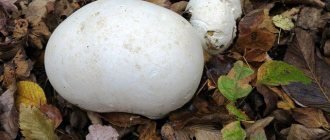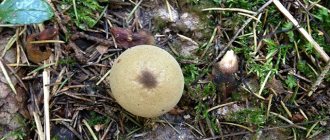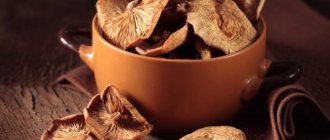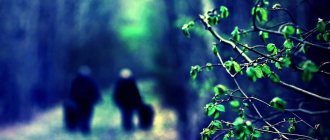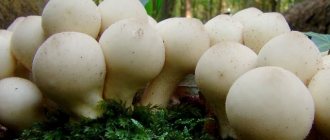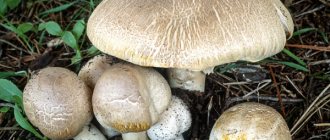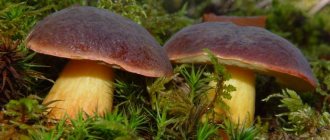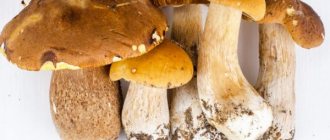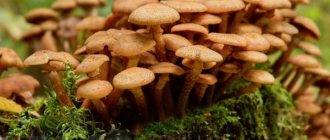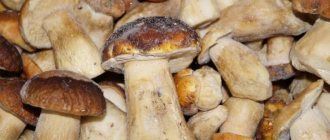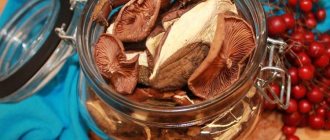Going for mushrooms: what do you need to know to check mushrooms for toxicity?
So, the very first step in silent hunting is preparation for collecting mushrooms. You need to check mushrooms for toxicity before you touch them. After all, if you collect inedible mushrooms in a basket, you will simply throw them away later, and if they are poisonous, then you should throw away the entire basket.
Important: toadstool is the most poisonous mushroom, which is very common in our latitudes. If you put the mushroom in a basket, you must throw away the contents of the entire basket, thoroughly wash the basket and treat it with chlorine before putting the mushrooms back into it.
Remember that pale toadstools at a young age are often confused with field and forest champignons. The stems of both mushrooms are identical and can be distinguished solely by the color of the plates. In champignons it is pink to brown, and in pale toadstools it is snow-white. Also, champignons grow in groups, and toadstools are found both in families and individually.
How to distinguish toadstool from mushrooms
Mushrooms are divided into tubular and lamellar. There is a false theory that among the lamellar mushrooms there are many poisonous mushrooms, but the tubular mushrooms are all edible and conditionally edible. This is a lie, and an insidious one, thanks to which many novice mushroom pickers put poison in their baskets.
Tubular poisonous mushrooms:
- Satanic mushroom / Satanic bolete;
- Wolf boletus;
- Boletus purple;
- Boletus le Gal;
- Boletus pink-purple;
- False satanic mushroom.
Gall mushroom, Pepper mushroom, Satanic mushroom - poisonous tubular mushrooms
Today, many call these mushrooms conditionally edible, but if you are not ready to experiment with your health and life, take pictures of them, enjoy the aesthetic beauty of nature and leave the poison in the forest.
Another controversial issue in recent years is the red fly agaric. A poisonous mushroom, which has recently been classified as conditionally edible if prepared in the “correct way”. If you don’t want to take risks, leave fly agaric mushrooms to extreme sports enthusiasts, because the forest is filled with edible and tasty mushrooms!
Let’s summarize: before you go mushroom hunting in the forest for the first time, study all the edible, non-edible, conditionally edible and poisonous mushrooms in your region.
Next, if you are going to the forest for the first time, look for mushroom pickers among your friends and ask to join them. Coordinate with them the collection of each mushroom, and through experience you will be able to safely undergo “baptism” into quiet hunters.
In addition, there are some tips from experienced mushroom pickers:
- Put several bags in the basket, and unknown mushrooms, or those that are in doubt and you cannot check for toxicity in the forest - put them in these bags. Each type - 1-2 mushrooms, large and small, for identification, and in case of edibility - tasting at home;
- Study the mushrooms of your region from the Red Book - and do not collect them, as you may receive hefty fines;
- Study descriptions of the taste values of mushrooms. How do they smell, do they release juice when cut, do they change color when cut. This will help determine whether the mushroom is edible or poisonous;
- Download a mushroom identification application to your phone that works without the Internet and use it in the forest.
How to determine when cooking whether the mushrooms are poisonous or not?
Few people know how to identify poisonous mushrooms when cooking.
In addition, few people know that they cannot be 100% classified as plants, since they contain signs of the animal world too. There are about 1.5 million species, subspecies and varieties of mushrooms in nature. This figure is a bit approximate, since scientists and avid mushroom pickers are discovering more and more new specimens. Science does not have an exact number of edible and poisonous mushrooms. It is believed that their percentage is 50/50, that is, they are equally divided.
Poisonous mushrooms can also be identified at the cooking stage.
This product is a common and favorite dish of many. In some national cuisines this product occupies a special, privileged place. Mushrooms can be pickled, salted, dried, served fried or boiled. There are a lot of recipes with this delicacy. Food with them acquires an extraordinary, unforgettable taste, and dishes decorated with this dish are a delight to the eye on any holiday table.
By what signs can you distinguish an edible mushroom from an inedible one in the forest?
It is important to remember that the signs by which you can distinguish an edible mushroom from an inedible one in the forest are very conditional, and if you are not sure that the mushroom is not poisonous, you can pick one large and one young one for identification, without touching with your hands, using a plastic bag, tied his. Study at home in the same way, without contacting dishes and other mushrooms.
Important: honey mushrooms a priori do not exist in coniferous forests! These are poisonous brothers. Remember this rule.
Signs by which you can check mushrooms for toxicity or edibility. Lies and truth:
- There is a skirt on the stem of edible mushrooms. This statement is very common, but false! Yes, most edible mushrooms have skirts, but the fly agaric also comes with skirts. Remember this, your life and the lives of your loved ones depend on it!
- Under the cap there is a tubular layer . And again a lie. Above we have listed the poisonous tubular mushrooms;
- Juice is released from the cut - evidence of the toxicity of the mushrooms. Some types of russula are classified as laticifers. As you can tell by the name, you can even eat them raw. But the liquid on the cut and fracture scares off many. At the same time, the pink milkweed is poisonous. There are also species of laticifers classified as inedible;
- The color changes on the cut of the mushroom . Oh, how many Polish mushrooms were thrown away solely because of a change in color at the point of contact, a break or a cut. Although the mushroom is incredibly tasty and its taste is better than butter.
- Poisonous mushrooms that change color when cut : satanic, gall, mustard. Edible mushrooms that change color when cut: boletus, boletus, Polish, also called boletus, bruise (collection is prohibited, listed in the Red Book);
Edible mushrooms with an unusual color on the cut/break: 1 - boletus, 2 - boletus, 3 - polish, 4 - blue
- The mushroom has a pleasant smell - this is not at all a sign of edibility. Yes, when collecting edible mushrooms, after cutting or breaking, you smell the mushroom as another way of identification. But poisonous mushrooms often also smell very pleasant, so treat this method of identifying a mushroom as auxiliary, but not the main one;
- Bugs or worms are noticed , which means they are edible for humans. Or, if an animal eats it, it is also edible for humans. Remember that humans and animals/insects have different digestive systems, and what is good for one is deadly poison for another. This rule is false;
- The bright color of mushrooms is a sign of toxicity. But then chanterelles and saffron milk caps would also be poisonous! The color of mushrooms depends on their type;
- The sticky, sticky cap is a sign of toxicity . Yes, many poisonous mushrooms have a sticky cap, but boletus mushrooms also have one, for example;
- The smell is foul, chlorine, smells like medicine . But this is a clear sign that the mushroom is inedible, even if you are 100% sure of it. Mushrooms actively collect all poisons and emissions from the environment, and even the proven white mushroom or butterfly can be inedible if it grows near toxic waste or factories.
Main characteristics of mushrooms
Scientists argued for a long time about milk mushrooms, boletuses and their relatives, not knowing where to classify them. They contain approximately the same amount of protein as animal food, and minerals and vitamins as in plants. Only in 1960 were they identified as a separate mushroom kingdom.
Accurate criteria for distinguishing good species from dangerous ones have not yet been developed. Fans of “silent hunting” rely on their own experience, which is passed on from generation to generation. In this case, the main rule must be strictly observed: do not take copies that raise even the slightest doubt. Otherwise, one small mushroom can ruin your whole life.
Characteristic criteria for edible species
The general features are very vague and averaged.
The main ones include:
- absence of a ring on the leg;
- tubular structure;
- the inner pulp of the fruiting bodies is light in color;
- the hat has catchy bright colors;
- absence of bitter taste and pungent odor.
These differences are conditional. For example, the pale grebe has a white tint on the break and has a weak smell, although it is poisonous. It is worth paying attention to the place of growth. Typically, false colonies are located away from areas where good mushrooms grow. To determine for sure whether a mushroom is edible or not, it is better to consider each of them separately.
This is what is most often found in mushroom pickers' baskets.
Boletus
One of the most popular types. Tough as a turnip. Tasty both boiled and fried. People call it “redhead” for its bright hat. The leg has characteristic black specks. If you cut it, it turns blue. It grows not only in aspen trees, but also under other deciduous trees. An aspen boletus grown in a clearing in the grass may have a pale scarlet or even colorless cap and a white leg without black specks. Young redheads have a spherical cap, pressed against the stem; as they grow, the head straightens and thickens. It practically does not grow in coniferous forests.
boletus
It has many subspecies, differing in color and taste. The shades of the cap range from light gray to dark brown. The leg is cylindrical with black scales. As it grows it becomes fibrous. The most delicious specimens grow at higher elevations. They are strong and resilient. The dark cap has light brown spots on the bottom. On the edges of swamps, watery specimens grow - moss mushrooms. In the basket, they are squeezed by other mushrooms and turn into shapeless mush. They are collected when there is nothing else. In terms of taste, boletus mushrooms are significantly inferior to aspen boletuses.
Polish mushroom (yellow mushroom, chestnut moss mushroom)
It has a yellow or brown top with a tubular structure and a leg of the same color, which is darker at the root. Turns blue when cut. Suitable for frying, soups, pickling. When dried, it acquires a pleasant yellow color. Not all mushroom pickers collect them when there is a harvest of more tasty species.
Kozlyak (sheeper)
It grows in colonies in meadows and deciduous-coniferous forests. Champion in worminess. Coloring ranges from light yellow to dark brown. Turns blue when cut. Some consider it inedible, others do not take it because of its low taste and unsightly appearance in soup. This is true. But in dried form, it can be compared with the legendary porcini mushroom, especially if young specimens are dried whole. At the same time, they do not turn black, maintaining their natural color. A delicacy for deer, that’s why goat is also called “deer mushroom.”
Ryzhik
It does not grow everywhere, but is considered the royal mushroom. Very nutritious and high in calories. The color of this forest gift also determined its name. Moreover, both the leg and the lamellar cap are red, on which there are sometimes greenish circles or dark gray spots on top. The pulp is also dark orange, changing to brown or greenish when cut. It grows mainly in spruce forests, hiding in old conifer needles that have fallen to the ground. Suitable for all types of processing except drying. Good for pickling.
Volnushka
One of the most sought after forest gifts. It often appears on tables in salted form. It has a light brown or beige stem and a reddish-red cap with characteristic rings. In young voles, mohra grows around the circumference of the top, the edges bend downwards. The pulp is dense. White milk appears on the cut. It is better to collect small specimens before the flesh becomes loose and wormy.
Common white breast
The king of lamellar mushrooms. Ideal for pickling, but you need to soak for a long time, several days. It’s especially tasty with trumpets. In this case, it does not stick together. The harvest does not occur every year. The optimal diameter of the cap for collecting is 5-7 cm. It likes to hide under fallen leaves due to its short white stem. In appearance it looks like a wave. The same moss, with curved edges at the beginning of growth, with brown rings on the cap, which is denser, but the color is white. Of the lamellar species, milk mushrooms are the strongest. White or yellowish milk appears on the cut. Loves moisture and pine needles. There is also a yellow mushroom (aspen). It turns purple when cut.
Russula
Universal look. As the name suggests, it is even suitable for consumption raw. It’s good in soup, fried with potatoes, pickled, and salted. Not suitable for drying. Many people do not like russula, considering them second-class mushrooms. This is wrong. There are mushroom pickers who collect only this species, which is distinguished by a variety of colors: red, orange, purple, gray-green. The leg is white. The cap is plate-shaped. The only negative is that it crumbles a lot, which not everyone likes. The strongest are young specimens of orange or greenish color. Their head is semicircular and dense.
Walui (kubari)
In terms of taste, it is close to milk mushrooms. Grows selectively. Young specimens have a ball-shaped cap. Its color ranges from beige to dark brown. Good for pickling.
Raincoat
It has many names: hare potato, gypsy powder, wolf tobacco. Only young fruiting bodies in the shape of a needle-shaped white ball with dense pulp are used for food. When ripe, the spores darken and turn into dust, and the mushroom itself transforms into a dark brown or black sac. If you step on the shell, it contracts and a column of dust appears in the air.
Signs of toadstools
The most important criterion by which poisonous mushrooms can be identified is the structure of the cap. If it is tubular, you can safely put the find in the basket. There are no mortal dangers among them, and if the trophies are subjected to heat treatment, then there is no need to be afraid at all.
In addition to the main one, you should pay attention to other signs characteristic of dangerous finds:
- skirt (ring) near the hat;
- thickening (vulva) on the pedicle in the root area;
- the flesh on the break turns red;
- unpleasant strong odor.
Toadstools common in Russia
There are not so many dangerous mushrooms in the world. But it is unlikely that Russians will be interested in reading about the deadly “angel of death” from the fly agaric family, growing in North America. But about dangerous finds that can end up in a mushroom picker’s basket in our country, information will not be superfluous. There are only a few deadly species among them, but there is no need for serious stomach upset either. He who is forewarned is forearmed.
Omphalote olive
It grows, for the most part, in Crimea, and now it is ours. It is found on rotten trunks of deciduous trees and rotten stumps. It looks like a chanterelle, but it has a nasty smell - a sign of the presence of the toxic substance illudin S, which can cause severe pain, attacks of diarrhea and vomiting.
Foliotina wrinkled
Occasionally found in the European part of Russia. Contains the potent poison amatoxins. Foliotina masquerades as Psilocybe blue. The toxin is deadly to the liver and is often fatal.
Russula pungent
Many will be surprised to see it on the list of dangerous forest products, because it is found everywhere, but more often in the North. At all times it was collected and eaten. The fact is that the poison muscarine appears only in its raw form. And if russula is prepared correctly, it becomes completely harmless. Having consumed the find in its raw form, the victim will end up with an upset stomach, pain in the abdomen, diarrhea and vomiting - typical poisoning.
Thin pig
Loves temperate climates, humid forests: coniferous, deciduous, mixed. More common in the Northern Hemisphere. Previously, pigs were classified as conditionally edible. Its toxicity has recently been proven. If consumed regularly, it can cause severe poisoning. People with kidney disease are especially affected. The fungus can cause kidney and respiratory failure, blood clotting in blood vessels, and shock. It can be found not only in forests and shelterbelts, but also in gardens.
Greenfinch
Prefers sandy soils and coniferous forests of the European part of Russia. Until the beginning of the 21st century, greenfinch was considered edible. The opinion changed in 2001, when 12 cases of poisoning were recorded at once, 3 of them were fatal. In all cases, a lot of mushrooms were eaten.
Signs of poisoning:
- sweating;
- nausea;
- convulsions;
- pain;
- muscle weakness.
Ergot purpurea
An unusual parasitic mushroom in the shape of a tooth that you need to know about. It most often grows in ears of rye instead of grains, but is also found on other grains and some grasses. During the Middle Ages, an epidemic even broke out due to the massive consumption of contaminated rye bread. Both people and domestic animals were sick, and the epidemic itself from infected grain was called “St. Anthony’s fire.” Ergot contains alkaloids with neurotoxic and psychotropic effects. Intoxication is fraught with mental disorders, prolonged spasms, and convulsions. Death often occurs.
The talker is whitish
It grows everywhere in Russia: in forests, fields, near human habitation. Develops in colonies. The color is whitish. The conical cap transforms into a funnel as it grows. Intoxication when consuming the mushroom begins quickly.
Symptoms of poisoning are observed within 20-25 minutes:
- tearfulness;
- sweating;
- slow heart rate;
- pressure drop.
Panther fly agaric
One of the three most dangerous mushrooms in Russia. It has a memorable appearance: a brown cap with white warts. It grows in both deciduous and coniferous forests. Many people confuse it with the red (edible) fly agaric, but the panther fly agaric is highly poisonous. The poisoned person faces suffocation and paralysis a couple of hours after consumption, so urgent hospitalization is required.
Amanita stinking
The dangerous mushroom lives up to its name. It gives off an unpleasant smell of rot. The stench it spreads discourages mushroom pickers, so there are few deaths. Loves the damp soil of coniferous and mixed forests. The white conical cap glistens with abundant mucus. The thin long leg has a growth in the middle. Severe intoxication occurs even from a piece of fly agaric, but signs of poisoning are noticeable only after a few hours. During this time, the poison penetrates various organs. The victim must be hospitalized in a medical facility.
White grebe
Like the stinking fly agaric, it is rarely found in mushroom pickers’ baskets due to its noxious odor. The white toadstool has a long leg and a conical cap. The poison is so strong that even a small piece of the fruiting body is enough to cause serious intoxication, the signs of which appear many hours after the moment of poisoning. The victim's condition worsens before our eyes, and his blood pressure drops. Urgent hospitalization is required.
Checklist for checking mushrooms for toxicity or edibility in the forest
We have prepared a checklist for a novice mushroom picker to accurately check mushrooms for toxicity or edibility in the forest:
- Get closer to the mushroom and identify the mushroom as much as possible (white, oiler, chanterelle, boletus, etc.). At this stage, you should not rush and reach out to him;
- By the way, most applications allow you to identify a mushroom from a photo that you can take without touching the mushroom;
- Next, identify the mushroom by its external characteristics: the shape and color of the cap, legs, the presence of a skirt or, on the contrary, its absence, grows in groups or singly;
- Assess whether the mushroom is a poisonous counterpart of an edible one, based on the above signs, if you pick one mushroom well;
- You evaluate it by the color and structure of the plates or tubular layer, by the smell, the condition of the cut (is the color changing, is there juice, etc.). If everything corresponds to what is edible and does not correspond to its poisonous counterparts, collect the delicacy in the basket;
- Remember that a quiet hunt is unhurried. At first it will take you about 5-10 minutes to identify a mushroom, but with experience the identification will be reduced to a minute. But you can never relax, because poisonous brothers are always hiding among the leaves and needles.
You need to know these mushrooms by heart if you go mushroom shopping
Misconceptions about recognizing edible and poisonous mushrooms
The people have several signs for identifying poisonous individuals, and many of them are erroneous. For example:
- It is believed that edible specimens are pleasant to the taste. Not true - fly agaric mushrooms are also tasty.
- Young fungi are safe; toxicity comes with age. This is not true, especially regarding the toadstool - it is deadly at any age.
- Poisonous mushrooms smell unpleasant. Nothing like this. Many poisonous and conditionally edible specimens have a pleasant aroma, while many have no odor at all. Representatives of the inedible category usually have an unpleasant odor.
- There is a widespread belief that poisonous mushrooms are not wormy - they are supposedly not to the taste of insects. Taking mushrooms that have been eaten away by worms and nibbled by snails into a basket, mushroom pickers think that these mushrooms are definitely edible. In fact, insects can live in any mushroom.
- Many are sure that alcohol neutralizes poison. Not true again. This misconception is especially dangerous - alcohol, on the contrary, contributes to the intoxication of the body with mushroom poison. If you drink poisonous mushrooms with alcohol, the likelihood of death increases.
- The opinion about the benefits of boiling mushrooms is also erroneous - boiling does not get rid of all poisons. There are toxins that are neutralized after boiling, and there are others that are resistant to high temperatures.
You cannot taste the mushrooms. Experiments can lead to severe poisoning. Fly agaric and toadstool taste good. Mushrooms need to be identified only by appearance.
When going on a “silent hunt”, it is important to know the exact description of edible mushrooms. If the specimen does not correspond to the description in any way, it is better to refuse it.
How to test mushrooms for toxicity at home?
So, the mushrooms have already been collected - all that remains is to identify them at home. In this section we will tell you how to test mushrooms for toxicity at home, as well as false advice that has sent not a single would-be mushroom picker to the hospital bed.
- Mushrooms that you doubt, take them home separately from the total mass in a bag;
- Identify houses using a book, an application or the Internet;
- Look for signs that can help identify this mushroom, as well as its inedible and poisonous counterparts;
- And only after a thorough check do you eat it.
Important: it is believed that russulas can be eaten raw, but if there is a problem with the gastrointestinal tract, pancreas, gall, liver - even russulas can cause eating disorders, pancreatic attacks, etc.
Experienced mushroom pickers also prepare most mushrooms without pre-boiling, but if you have problems with the gastrointestinal tract, it is better to pre-boil, or try eating without this type of processing in small portions to make sure it is tolerable.
Edible mushrooms
Myths and true tips on how to test mushrooms for toxicity at home:
- Cooking mushrooms with onions. The color of the bulb changes depending on the types of mushrooms and their combination, and not on the poison in the mushrooms. This is the most common myth, because of which people end up in a hospital bed, or even ends in death;
- A silver object changes color when cooked with mushrooms - there are poisonous mushrooms in the pan. This is a lie again. Silver may also darken when cooking boletus, Polish mushroom, etc. After all, it darkens from secreted enzymes, and not from poison;
- To disinfect, mushrooms are boiled in a vinegar-salt solution, but this not only does not disinfect, but also spoils the taste of the mushroom. Then it’s better to buy it in the store and enjoy the taste of probably edible mushrooms;
- Testing with milk also works - here again, milk can curdle from both poisonous and edible mushrooms.
To summarize: it is impossible to test mushrooms for toxicity during cooking.
There is also a myth that if you lick a mushroom, you can tell whether it tastes edible or not. It is important to remember that the fly agaric tastes very good, but it causes no less deaths than the toadstool.
And one more piece of advice in conclusion : alcohol does not neutralize poison, but aggravates intoxication. The statistics are inexorable - poisonous mushrooms plus alcohol equal death.
How to distinguish doubles?
Edible mushrooms, which are hunted by mushroom pickers, have counterparts - inedible, conditionally edible or poisonous. Here are the most famous pretenders:
- Gall and satanic mushroom. These are twins of boletus - the most valuable representative of the mushroom kingdom. But distinguishing doubles is easy. The first one has a dark network of veins on the leg, the second one has a reddish one. You can also cut off a piece of the leg to see if its color changes. If after a minute the color of the cut does not change, the boletus can be placed in the basket. In twins, the color will change from white to pink - for the gall mushroom, and purple - for the satanic mushroom.
- False boletus. His hat is darker than the real one. The color of the cut leg does not change, but in a real redhead, on the contrary, it darkens.
- False boletus. It can be distinguished from an edible mushroom by its darker cap and bluish cut. Another sure sign is the place of growth. False boletus does not grow under birch trees.
- False chanterelles. To distinguish them from edible ones, you need to be careful. Look at the color of the hats. In real chanterelles they are light orange, almost yellow. False specimens have a bright orange color, and when broken, drops of white juice appear.
- False honey mushrooms. There are many poisonous and inedible mushrooms that look similar to honey mushrooms. Real mushrooms can be distinguished from false ones by their brownish or brownish-yellow scaly cap. Moreover, the caps are pale, while the false caps are bright, for example, red-brown or rusty-red. Edible honey fungus can also be identified by its smell - it has a pleasant and rich mushroom spirit. False mushrooms emit the smell of mold and damp earth.
Is it possible to get poisoned by edible mushrooms from the forest?
When considering the question of how to test mushrooms for toxicity, one cannot help but mention the huge problem of our time - poisoning by edible mushrooms from the forest.
- Bacterial infection . Russulas and pickles are favorite delicacies not only for northerners, but there are many nuances to this issue. Russulas can be eaten raw within an hour after being picked; pickles are permissible only after thoroughly washing and processing the mushrooms. Otherwise, there is a risk of bacterial poisoning. But when cooking, frying, stewing, this method of poisoning is reduced to zero;
- Old mushrooms . Yes, yes, if the mushroom is edible, but old, you can be poisoned by it;
- After harvesting, the mushrooms must be washed, peeled and heat treated or frozen for 12 hours. Otherwise, there is a risk that the mushrooms will spoil and you could be poisoned by them;
- Clostridia spores and botulism . This terrible scourge concerns not only improperly rolled mushrooms, but also other preserved foods;
- The presence of toxins in mushrooms can lead to poisoning. Therefore, mushrooms can only be collected in environmentally friendly areas;
- Individual intolerance and overeating to mushrooms . It is worth considering that mushrooms are a very heavy, albeit tasty product. It’s easy to overeat mushrooms, but the consequences can be very sad.
People's "testing"
People have come up with a lot of methods to identify poisonous representatives of the mushroom world. Unfortunately, many of them are not effective, since they are designed for the reaction of a specific poison or group of poisons. Moreover, many methods are erroneous, and the price of error is human lives. Let's figure out what methods there are, what exactly they define, and why they cannot be trusted.
Silver check
There is a popular belief that toxicity can be detected using silver objects. This is a flawed method that should not be relied upon. Silver darkens not from poisons, but from certain amino acids, which can be contained in any mushrooms, regardless of their edibility.
Checking with garlic and onions
Mushroom pickers have another way to check for quality - already during cooking. Throw an onion or garlic into the pan. If there is a poisonous specimen there, they turn blue. I have to throw away undercooked soup. But onions or garlic turn brown not at all from poison, but because of tyrosinase - this is a special enzyme that has no connection with edibility - it can be contained in both toxic and edible specimens.
What will the insects tell you?
Among some mushroom pickers there is a belief that poisonous mushrooms are not eaten by insects. In fact, the presence of insects does not mean anything - among them there are species resistant to poisons.
Mushroom poisoning: what to do?
It happens that no matter how the mushrooms are tested for toxicity, the worst thing happens - mushroom poisoning. There are clear instructions on what to do in this case:
- If there are signs of poisoning, and you have eaten mushrooms within 24 hours, or even more so for several hours, immediately call an ambulance , and when calling, report that it is mushroom poisoning. This increases the chance of survival by 50%. After all, mushroom poisoning progresses quickly, from nausea to death;
- Without waiting for an ambulance, induce vomiting, both in yourself and in everyone who ate mushrooms with you;
- Drink a solution of potassium permanganate 1-2 liters;
- If there is no potassium permanganate - 1-2 tablespoons of salt per liter of water and drink as much as possible;
- After the stomach is cleansed, drink activated carbon or another sorbent;
- Next, drink sweet tea and mineral water in large quantities.
Mushroom poisoning
Tips for beginner mushroom pickers
It is better for beginners to go to the forest in the company of experienced mushroom pickers. If you have the slightest doubt, they will provide competent and comprehensive advice based on their extensive experience. At the same time, they will show you mushroom spots and teach you how to navigate correctly.
When going on a “silent hunt”, you need to choose the right clothes. It should be loose and well protected from insect bites. Indispensable attributes are a hat and closed shoes. If there are ticks in the forest, trousers are tucked into boots, and a jacket into trousers. These dangerous insects always crawl from bottom to top. It's a good idea to tie a scarf.
Then the places that ticks love so much will become inaccessible:
- groin area;
- armpits;
- depressions behind the ears;
- neck.
A wicker basket made from pine shingles, wicker, or birch bark is the best container for harvesting because it breathes. An experienced mushroom picker will never collect boletus and boletus mushrooms in a plastic bucket or plastic bag.
Many beginners think: the further into the forest, the more gifts of the forest, and they are mistaken. In dense areas, redheads, boletuses, and boletus grow reluctantly. There are much more of them in places with sparse vegetation or border strips: on the edges, along the banks of streams and lakes, along the edges of ravines, along forest paths, in clearings.
Where you can't pick mushrooms
Representatives of the mushroom kingdom have one peculiarity: they accumulate all the harmful substances contained in the soil. Therefore, experts do not recommend collecting forest trophies closer than 500 meters from country roads and 1000 meters from federal highways. Otherwise, combustion products of gasoline and diesel fuel may enter the body: organic compounds of lead, oxides of nitrogen, sulfur, carbon, and this is unsafe for health.
You should also not collect forest gifts if nearby:
- Railway;
- oil storage;
- agricultural grounds;
- nuclear power plant;
- factory or plant.
You cannot buy honey mushrooms, milk mushrooms, and white mushrooms from private individuals standing along the roads. It is unknown where they collected. In addition, among the good specimens, the inedible one can easily get lost.
The first signs of poisoning
Many dangerous representatives of the mushroom kingdom have similar symptoms of poisoning, but symptoms can be observed at different times - from several hours to a day and a half.
They appear as follows:
- temperature increase;
- drop in blood pressure;
- uncontrollable vomiting;
- diarrhea;
- convulsions;
- in case of fly agaric poisoning - hallucinations;
- pain in the stomach;
- sometimes loss of consciousness.
How to provide emergency assistance
At the first signs of intoxication, you must urgently call an ambulance.
Before the doctors arrive, the victim is prescribed a number of procedures:
- Gastric lavage. The patient should drink a weak solution of potassium permanganate. Then, pressing with your fingers on the root of the tongue induces vomiting. (Repeat step 1 3-5 times).
- If there is no diarrhea, you need to drink a saline solution or a gentle laxative.
- Take several tablets (1 piece per 20 kg of weight) of activated carbon to remove toxins from the body.
- To restore water balance, give the patient small drinks in small portions so as not to provoke vomiting.
- Place 2 warm heating pads on your legs and stomach.
It is strictly forbidden to give alcohol to the victim. This can dramatically worsen his condition.
How to test mushrooms for toxicity: tips and reviews
Lyudmila : I have been collecting mushrooms since childhood and, despite the fact that I thoroughly know all the forests, meadows and swamps that surround me, as well as what mushrooms grow when, when I came to visit the Moscow region, I discovered very interesting specimens. She became interested and put it in a bag, asked the mushroom pickers who came across - no one knew, and they said, they saw it but we don’t take it. Already at home I found on the Internet that this is another type of russula. We spoiled it with friends - very tasty!
Inna : I started going mushroom hunting with my husband during quarantine. On the advice of friends, we took one specimen with us, if we didn’t know it, and took several photos in nature, because by the time you get home you don’t remember what was there and how it grew. Over the course of a couple of seasons, we went from novices walking through the forest with a knife to becoming very conscious and wise mushroom pickers, with our own catalog of edible and non-edible mushrooms. By the way, advice to beginners - we strongly recommend double-checking the information after the “old mushroom pickers”; a couple of specimens that we were told were edible in the forest turned out to be poisonous! Not all retirees are experienced and knowledgeable.
You may also like our other topics about mushrooms:
- Do you need to add carrots, garlic, bay leaves, herbs to mushroom soup: what do you add besides mushrooms?
- How to defrost mushrooms before cooking soup or frying?
- I over-salted mushrooms when pickling: what to do, how to fix it?
- How many days after cooking can you eat pickled mushrooms?
How to provide first aid in case of poisoning?
If poisoning occurs, you need to consult a doctor as soon as possible. Before the ambulance arrives, it is recommended to drink more fluids; milk, water with a small amount of potassium permanganate or salted water will do. You can rinse the stomach and artificially induce vomiting several times. It is better to take a horizontal position. You can put a bandage soaked in cold water on your forehead, but you can warm your legs and stomach with a heating pad or blanket. There must be someone near the victim who has not eaten mushrooms, so that if the patient loses consciousness, they can give him a sniff of ammonia. In a state of poisoning, the victim should not remain unconscious for a long time, otherwise he may fall into a coma.
How long to cook dried mushrooms
Dried mushrooms are a real winter delicacy. From them you can prepare many delicious, aromatic, amazingly tasty first and second courses, baked goods, snacks and salads.
However, to restore the original properties of the mushroom, it is important to know how long to cook the mushrooms after drying.
Improperly prepared dried mushrooms lose both taste and pleasant texture and become too tough. First of all, they should be soaked in fresh cold water.
Four hours of soaking will be enough to restore the elasticity and volume of the mushroom slices. You don’t have to drain the water after soaking, because the mushrooms give it their amazing aroma and taste.
Of course, you need to focus on results. If the mushrooms were prepared incorrectly, the water will become dirty, cloudy, clogged with leaves, pine needles, and sand. You shouldn’t cook mushroom “meat” in this.
As a rule, porcini mushrooms are dried. However, you can dry boletus, boletus, morels, moss mushrooms, champignons, chanterelles, etc. How long should you cook dried mushrooms after soaking?
At least half an hour. You can check readiness by whether the mushrooms fall to the bottom of the pan after rising above the surface of the stove.
Depending on the degree of drying, it may take longer to cook the mushroom slices. To prepare a delicious decoction based on porcini mushrooms, you can use the following recipe.
Ingredients:
- three hundred grams of dried slices of porcini mushrooms;
- one and a half liters of water;
- salt;
- Bay leaf;
- peppercorns (optional).
Preparation
Pour boiling water over the mushrooms so that all the slices are under water. You can press them down on top with a plate or lid.
After three to four hours, pour the swollen mushrooms into a pan of boiling water for the broth.
Throw in the bay leaf, pepper, and add salt to the broth to taste.
Canning correctly
Photo: floragrauso
Different types of mushrooms need to be preserved separately: they all tolerate boiling differently and have different ripening periods. It is also necessary to remember that hermetically sealed jars are an ideal place for bacteria to multiply, so it is better to preserve mushrooms under plastic lids. Home canned food can only be stored in a cool place.
Tips for mushroom picking enthusiasts
Before you start harvesting mushrooms, you need to know the following:
- carefully study the area where mushrooms grow, so as not to come across duplicates that contain poison. It is better to go into the forest with an experienced person who can distinguish poisonous mushrooms from edible ones;
- if in doubt, it is better not to take this or that mushroom;
- checking the mushroom should not be delayed; you need to check them immediately after returning home;
- overgrown mushrooms do not need to be picked, because toxic substances can be deposited in them;
- Upon returning home, sort the mushrooms, and then wash, clean and process them. You should not store fresh mushrooms in the refrigerator for a long time.
It is not recommended to collect mushrooms in places where chemical plants are located nearby. If you pick mushrooms in such an area, no amount of careful checking will help avoid digestive upset.
Mushrooms turn black: all the reasons and dangers
Let's find out why mushrooms turn black and whether it is dangerous to eat such specimens...
Blackness on a mushroom is not something extraordinary. There are many scenarios for its appearance. If the mushroom has been stored for a long time, black spots may also appear on it.
Cleaning, cooking, frying are the most common scenarios for blackening of the mushroom. Let's find out!
Mushrooms turned black when peeled
Many mushrooms (champignons, boletus mushrooms) become dark during cleaning.
Blackness after cleaning is a normal process caused by the oxidation of polyphenols
And after cleaning, pigments are formed in the mushroom (if the mushroom is not damaged, then there will be no pigments).
How long to cook frozen mushrooms
You can cook the same wonderful dishes from frozen mushrooms as from fresh ones. They freeze champignons, boletus, white mushrooms, honey mushrooms, chanterelles - almost everything that can be brought from a successful mushroom hunt.
How long to cook frozen mushrooms? Before answering this question, you need to know how to prepare mushrooms for cooking.
The fact is that it is not possible to remove all the moisture from mushrooms before freezing: a small amount of ice will certainly form on them. You can’t throw mushrooms in this state into the pan, they will ruin the whole thing. Therefore, the mushrooms need to be defrosted first. You can do this in several ways:
- microwave for a couple of minutes;
- leave in a colander at room temperature and wait for natural thawing.
After the mushrooms have thawed, they must be washed in running water. Then everything is simple: add water to the mushrooms and put them on the fire. After boiling, reduce the heat to low and simmer, covering with a lid. Be sure to stir from time to time and remove the foam with a slotted spoon.
How long to cook frozen mushrooms? For complete readiness, 20-30 minutes will be enough. The champignons will be ready in 15 minutes.
